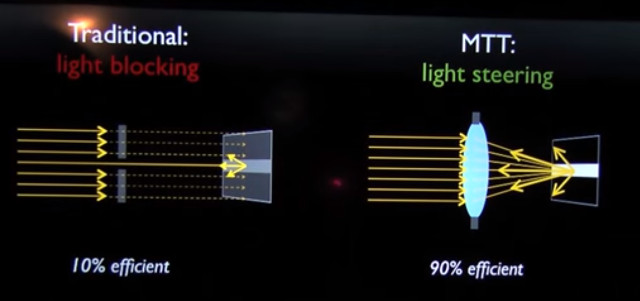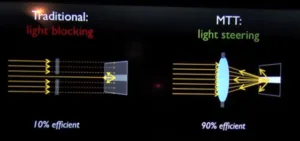The most impressive demo at this year’s CinemaCon was the light steering projector in a room marked “Vision 2020” in the Cinionic booth. This is still a prototype, but Cinionic is now seriously looking at how to commercialize the technology. Although no time frame was given, a commercial launch at next year’s CinemaCon is not unreasonable.
The technology has been in development for a number of years at a small company called MTT Innovation near Vancouver, Canada. The group has a long history of working with HDR technology, having formed Brightside Technologies, which was later acquired by Dolby which nurtured the technology to become Dolby Cinema and Dolby Vision. Barco bought MTT Innovation a couple of years ago and has been helping in development. (and covered at Display Daily – A New Way to Create Projected HDR?)

The key developers, Anders Ballestad and Gerwin Damberg, have not disclosed much about how the technology works. But, it is not a dual modulation technology like the Dolby Cinema approach, which works very well at creating deep blacks and a 1M:1 contrast ratio, but struggles to boost peak luminance above 110 nits due to the massive inefficiency of the approach.
MTT Innovation says they can “shift light from darker areas to areas that are brighter, thereby increasing the intraframe contrast.” They do this with “phase modulation” but have said nothing else on how this works technically.
So let me offer up a guess on how it works. But first, let’s discuss a Heads-up Display technology developed by Two Trees Photonics and which is in use in Land Rover and other cars today. This technology features an LCOS panel that operates as a spatial light modulator. That is, instead of writing speedometer and turn signal information to the display, they convert the image into the frequency domain (perhaps via a Fourier transform) and write this pattern (essentially a holographic pattern) to the LCOS panel. When illuminated by a laser, the light is transformed back into the spatial domain and the speedometer and turn signal information appears in the HUD. Why do it this way? Because instead of blocking 90% of the light to shown some simple symbology, all of the light gets redirected onto the symbology. This allows for a much brighter and/or more efficient solution.
So, maybe what MTT Innovations is doing is using a pre-modulator to create a pattern in the frequency domain that shifts light from darker areas to lighter areas. The light source is an RGB laser system and a conventional prism-based 3-DMD engine follows the pre-modulator. That would tend to make the darker tones blacker and the highlights brighter – just what you want to do. Remember, this is just a guess.
 MTT showed this diagram at Siggraph in a video in 2015
MTT showed this diagram at Siggraph in a video in 2015
What I can say is that I was very impressed with the images that were shown on a 30’ wide screen at CinemaCon. I saw the demo twice. The first time I saw Kingsmen in HDR and Aliens: Covenant and Collision Course in SDR and HDR. The second day I saw Red Sparrow in HDR, along with the SRD and HDR versions of Collision Course and the Aliens: Covenant.
Before bringing the projector to CinemaCon, it was at Fox Studios where it was used to grade the content shown at the event.
Highlights Brighter than Samsung LED
Cinionic/MTT Innovation did not want to comment on specific black levels or peak luminance levels as it is a prototype and a commercial version may look different. They stressed that Barco is focused on the mainstream part of the market, so a high performance high-priced version of the technology may not be what is commercialized. We will just have to wait and see on that one.
However, I can say that the HDR effect was very real and very impressive. Some of the highlights were in excess of 1000 cd/m² with the black levels looking essentially dominated by the contrast of the room (which has black curtains but a white ceiling). The Aliens: Covenant scene did not seem to reveal deep blacks or more detail in the darker tones when comparing the HDR to SDR versions and the midtones looked to be about in the same luminance range. It was the highlights that stood out with the glow in the spacesuit visor and other lights just popping out. These were definitely brighter than the Samsung LED screen.
The difference between SDR and HDR was most apparent in the animated clip of Collision Course. The colors were immediately brighter and more saturated (unclear how much of the perception of deeper saturation was from the higher luminance vs. the colorist pushing the saturation). Some of the shots showed a deep black space background with stars that looked “OLED like”.
All this is very impressive considering this is a projection system. I can’t wait to see what gets commercialized. – CC

